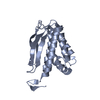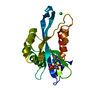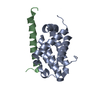+ Open data
Open data
- Basic information
Basic information
| Entry | Database: PDB / ID: 1ypy | ||||||
|---|---|---|---|---|---|---|---|
| Title | Crystal Structure of Vaccinia Virus L1 protein | ||||||
 Components Components | Virion membrane protein | ||||||
 Keywords Keywords |  VIRAL PROTEIN / VIRAL PROTEIN /  Vaccinia virus / Orthopox / Variola virus / Vaccinia virus / Orthopox / Variola virus /  smallpox / L1 smallpox / L1 | ||||||
| Function / homology | Virion membrane protein, poxvirus L1-related /  Lipid membrane protein of large eukaryotic DNA viruses / symbiont entry into host cell / Lipid membrane protein of large eukaryotic DNA viruses / symbiont entry into host cell /  viral envelope / virion attachment to host cell / virion membrane / viral envelope / virion attachment to host cell / virion membrane /  membrane / Entry-fusion complex associated protein OPG095 membrane / Entry-fusion complex associated protein OPG095 Function and homology information Function and homology information | ||||||
| Biological species |   Vaccinia virus Vaccinia virus | ||||||
| Method |  X-RAY DIFFRACTION / X-RAY DIFFRACTION /  SYNCHROTRON / SYNCHROTRON /  SAD / Resolution: 1.51 Å SAD / Resolution: 1.51 Å | ||||||
 Authors Authors | Su, H.P. / Garman, S.C. / Allison, T.J. / Fogg, C. / Moss, B. / Garboczi, D.N. | ||||||
 Citation Citation |  Journal: Proc.Natl.Acad.Sci.Usa / Year: 2005 Journal: Proc.Natl.Acad.Sci.Usa / Year: 2005Title: The 1.51-Angstrom structure of the poxvirus L1 protein, a target of potent neutralizing antibodies. Authors: Su, H.P. / Garman, S.C. / Allison, T.J. / Fogg, C. / Moss, B. / Garboczi, D.N. | ||||||
| History |
|
- Structure visualization
Structure visualization
| Structure viewer | Molecule:  Molmil Molmil Jmol/JSmol Jmol/JSmol |
|---|
- Downloads & links
Downloads & links
- Download
Download
| PDBx/mmCIF format |  1ypy.cif.gz 1ypy.cif.gz | 80.6 KB | Display |  PDBx/mmCIF format PDBx/mmCIF format |
|---|---|---|---|---|
| PDB format |  pdb1ypy.ent.gz pdb1ypy.ent.gz | 64 KB | Display |  PDB format PDB format |
| PDBx/mmJSON format |  1ypy.json.gz 1ypy.json.gz | Tree view |  PDBx/mmJSON format PDBx/mmJSON format | |
| Others |  Other downloads Other downloads |
-Validation report
| Arichive directory |  https://data.pdbj.org/pub/pdb/validation_reports/yp/1ypy https://data.pdbj.org/pub/pdb/validation_reports/yp/1ypy ftp://data.pdbj.org/pub/pdb/validation_reports/yp/1ypy ftp://data.pdbj.org/pub/pdb/validation_reports/yp/1ypy | HTTPS FTP |
|---|
-Related structure data
| Similar structure data |
|---|
- Links
Links
- Assembly
Assembly
| Deposited unit | 
| ||||||||
|---|---|---|---|---|---|---|---|---|---|
| 1 | 
| ||||||||
| 2 | 
| ||||||||
| Unit cell |
|
- Components
Components
| #1: Protein | Mass: 19532.877 Da / Num. of mol.: 2 Source method: isolated from a genetically manipulated source Source: (gene. exp.)   Vaccinia virus / Genus: Orthopoxvirus Vaccinia virus / Genus: Orthopoxvirus / Gene: L1 / Plasmid: pLM / Production host: / Gene: L1 / Plasmid: pLM / Production host:   Escherichia coli (E. coli) / Strain (production host): BL21(DE3)-CodonPlus-RIL / References: UniProt: P07612 Escherichia coli (E. coli) / Strain (production host): BL21(DE3)-CodonPlus-RIL / References: UniProt: P07612#2: Water | ChemComp-HOH / |  Water Water |
|---|
-Experimental details
-Experiment
| Experiment | Method:  X-RAY DIFFRACTION / Number of used crystals: 2 X-RAY DIFFRACTION / Number of used crystals: 2 |
|---|
- Sample preparation
Sample preparation
| Crystal |
| |||||||||||||||
|---|---|---|---|---|---|---|---|---|---|---|---|---|---|---|---|---|
Crystal grow |
|
-Data collection
| Diffraction |
| |||||||||||||||
|---|---|---|---|---|---|---|---|---|---|---|---|---|---|---|---|---|
| Diffraction source |
| |||||||||||||||
| Detector |
| |||||||||||||||
| Radiation |
| |||||||||||||||
| Radiation wavelength |
| |||||||||||||||
| Reflection | Number: 15507 | |||||||||||||||
| Reflection | Resolution: 1.51→50 Å / Num. obs: 52912 / % possible obs: 99.1 % / Observed criterion σ(F): 0 / Observed criterion σ(I): 0 / Redundancy: 3.7 % / Biso Wilson estimate: 23.5 Å2 / Rmerge(I) obs: 0.064 / Χ2: 1.058 / Net I/σ(I): 12.3 | |||||||||||||||
| Reflection shell | Resolution: 1.51→1.56 Å / Redundancy: 3.7 % / Rmerge(I) obs: 0.496 / Mean I/σ(I) obs: 3.55 / Num. unique all: 5290 / Χ2: 1.045 / % possible all: 100 |
-Phasing
Phasing | Method:  SAD SAD | |||||||||||||||||||||||||||||||||||||||||||||||||
|---|---|---|---|---|---|---|---|---|---|---|---|---|---|---|---|---|---|---|---|---|---|---|---|---|---|---|---|---|---|---|---|---|---|---|---|---|---|---|---|---|---|---|---|---|---|---|---|---|---|---|
| Phasing MAD set site |
| |||||||||||||||||||||||||||||||||||||||||||||||||
| Phasing dm | FOM : 0.74 / FOM acentric: 0.76 / FOM centric: 0.57 / Reflection: 6895 / Reflection acentric: 6398 / Reflection centric: 497 | |||||||||||||||||||||||||||||||||||||||||||||||||
| Phasing dm shell |
|
- Processing
Processing
| Software |
| ||||||||||||||||||||||||||||
|---|---|---|---|---|---|---|---|---|---|---|---|---|---|---|---|---|---|---|---|---|---|---|---|---|---|---|---|---|---|
| Refinement | Method to determine structure : :  SAD / Resolution: 1.51→50 Å / Data cutoff high absF: 10000 / Data cutoff low absF: 0 / σ(F): 0 / Stereochemistry target values: Engh & Huber SAD / Resolution: 1.51→50 Å / Data cutoff high absF: 10000 / Data cutoff low absF: 0 / σ(F): 0 / Stereochemistry target values: Engh & HuberDetails: The close contact between B5 (CB ALA) and B82 (CG GLU) may indicate flexibility in side chain of B82 as well as the disorder in B5, which is the n-terminus in that molecule. It is possible ...Details: The close contact between B5 (CB ALA) and B82 (CG GLU) may indicate flexibility in side chain of B82 as well as the disorder in B5, which is the n-terminus in that molecule. It is possible that there are alternate positions in both residues to support packing between the asymmetric units at this interface, but the model is the best fit that did not violate geometric requirements.
| ||||||||||||||||||||||||||||
| Displacement parameters | Biso mean: 58.345 Å2
| ||||||||||||||||||||||||||||
| Refine analyze |
| ||||||||||||||||||||||||||||
| Refinement step | Cycle: LAST / Resolution: 1.51→50 Å
| ||||||||||||||||||||||||||||
| Refine LS restraints |
| ||||||||||||||||||||||||||||
| LS refinement shell | Resolution: 1.51→1.6 Å / Rfactor Rfree error: 0.015
|
 Movie
Movie Controller
Controller













 PDBj
PDBj

